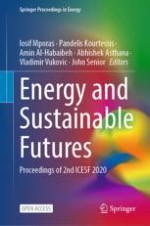This problem of density driven convection in a brine saturated porous medium is modelled in single phase comprising the flow of brine and the transport of CO
2 dissolved in brine. Each model aquifer is 2-dimensional in the cartesian coordinate system (x-z plane). The aquifer has a thickness
H, impermeable
(u = v = 0) and constant CO
2 concentration
(c = Cs) at the top boundary
(z = 0), and impermeable and zero CO
2 concentration flux
\( \left( {\frac{\text{dc}}{\text{dz }} = 0} \right) \) at the bottom boundary
(z = H). Initially
(t = 0), the domain is assumed to contain no CO
2 (c = 0). This initial and boundary conditions are common in the subject of convection in the context of the geological sequestration of CO
2 [
2‐
5]. The system of equations for this problem is
$$ {\text{v}} = - \frac{\text{k}}{{{{up\mu }}}}\left( {\frac{{\partial {\text{p}}}}{{\partial {\text{z }}}} - \left( { 1 + {{\beta c}}} \right){{\rho }}_{0 } {\text{g}}} \right) $$
(1.3)
$$ \emptyset \frac{{\partial {\text{c}}}}{{\partial {\text{t }}}} + {\text{u}}\frac{{\partial {\text{c}}}}{{\partial {\text{x }}}} + {\text{v}}\frac{{\partial {\text{c}}}}{{\partial {\text{z }}}} = \emptyset {\text{D}}\left( {\frac{{\partial^{2} {\text{c}}}}{{\partial {\text{x}}^{2} }} + \frac{{\partial^{2} {\text{c}}}}{{\partial {\text{z}}^{2} }}} \right) $$
(1.4)
$$ {\text{v}} = - \frac{\text{k}}{{{{\upmu }}}}\left( {\frac{{\partial {\text{p}}}}{{\partial {\text{z }}}} - \left( { 1 + {{\beta c}}} \right){{\rho }}_{0 } {\text{g}}} \right) $$
(1.5)
where
\( c, \) \( k, \) \( D, \) \( \emptyset \),
\( g \),
\( \mu \) and
\( p \) denote CO
2 dissolved concentration, permeability, diffusivity of CO
2 in brine saturated porous medium, porosity, gravity, viscosity and pressure respectively. The Darcy velocity components are
\( u \) in the horizontal and
\( v \) in the vertical direction. Boussinesq approximation is made so that the dependence of density (
\( {{\rho }} \)) on the concentration (
\( c \)) which is assumed to be linear
\( {{\rho }} = {{\rho }}_{0 } \left( { 1 + {{\beta c}}} \right) \) is applied only in the buoyancy term
\( \left( {{{\rho g}}} \right) \) in (3), where
\( {{\rho }}_{0 } \) is the density of pure brine and
\( {{\beta }} \) is the expansion coefficient. The length, time, and concentration scale are
H, the diffusive timescale
\( \frac{{H^{2} }}{D} \), and
\( C_{s} \) respectively. The velocity scale is
\( \frac{\emptyset D}{H} \), and the dimensionless pressure is expressed as
\( p^{\prime} = \frac{{\left( {p - \rho_{0 } gz} \right) }}{\emptyset \mu D} \). The main dimensionless number that describes the relative importance of diffusion and convection is the Rayleigh number,
\( Ra = \frac{{k\rho_{0} \beta C_{s} gH}}{\emptyset \mu D} \). The system of Eqs. (
1.1‐
1.4) is made dimensionless, linearized, and then analysed using linear stability analysis (LSA) based on the quasi-steady state approximation (QSSA) needed due to the transient base profile. The procedure and validity of QSSA have been discussed previously [
3].
